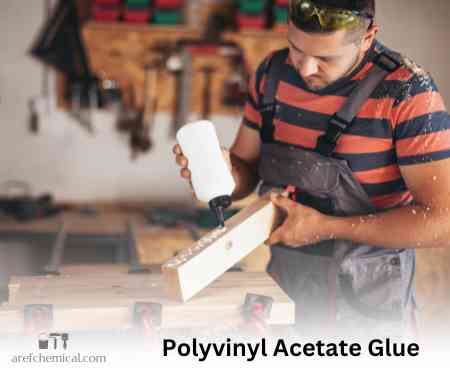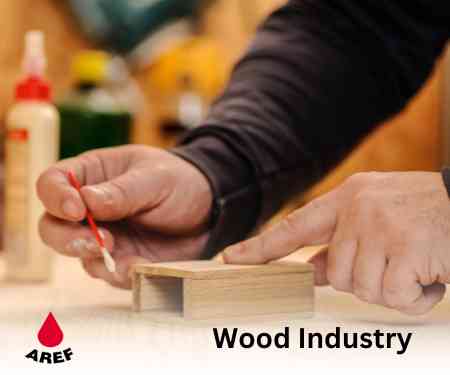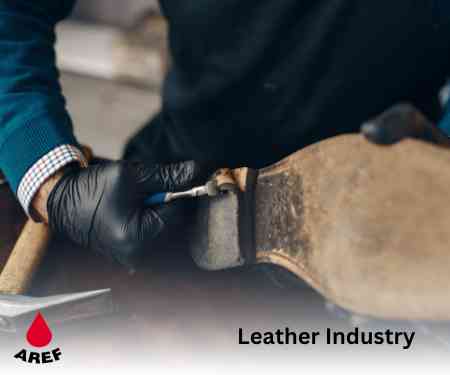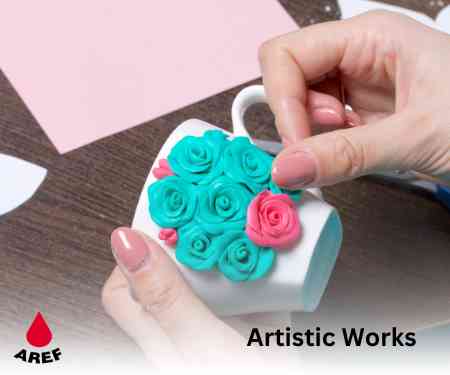PVA Glue
PVA or Polyvinyl Acetate with the chemical formula (C4H6O2)n)n is one of the most important polymers in the adhesive industry. Polyvinyl acetate (PVA) adhesives with the general name of white wood glue are included in the group of composite polymers that are used as other materials for wood products.
Organic compounds and polymers in the structure of wood glue give its molecules and increase the quality of the glue. Polyvinyl acetate adhesive has very different uses and is available in the market with two types of solvent base and water base.
Important Features of Polyvinyl Acetate Glue
This glue has a low resistance to moisture, but it offers acceptable resistance to oil, grease, and other petroleum derivatives. Wood glue is stable against light, but it softens at very high temperatures (above 45 degrees Celsius) and its concentration decreases.
In terms of price, it is economical and suitable, and by means of it, very strong and solid connections can be made for most projects. Made of completely non-toxic materials. The vapor released from this glue is not dangerous and this product is safe for all ages.
The drying time of this glue is about 12 to 24 hours, and this time changes according to the temperature of the environment, and in some cases, it even reaches 7 days for complete drying. Wood glue has a concentration similar to honey, and for that reason, it is very suitable and practical for filling small holes and sunken areas.
Wood glue is easily removed with water because its base is water. If it takes a long time for the glue to dry, it is better to use acetone, industrial alcohol, or vinegar to clean it. PVA glue does not change color over time and does not turn yellow. It also has very little smell.
| The pressure required to stick the standard | 1 megapascal |
| The best temperature for complete drying | 15 degrees Celsius |
| Full drying time | 12 to 24 hours |
Applications of PVA Adhesive Wood Industry
-
Wood industry
Wood glue has a high power to stick wooden plates and pieces together, and its main use can be considered in wooden projects. The durability of the connection created by PVA glue is very high.
-
Leather industry
This glue is not the first choice for connecting leather parts! But it has a good performance in this industry and does not harm the texture of the leather. If you want to separate them from each other after connecting the desired parts, your leather will be damaged. It can be used to attach leather bags and shoes.
-
Artistic works
The non-toxicity of polyvinyl acetate glue can be considered the most important factor for the use of this glue in artistic activities. From a child making crafts in kindergarten to a person working on hand-made projects for fun, they can use this glue without worry.
How to Work with Wood Glue?
Depending on the type of connection and the depth of the crack, you can use an appropriate amount of this glue. After the glue is in the desired place, give it enough time and temperature to dry completely. It is better to glue two wooden boards first by applying wood glue to both boards and then placing them on top of each other. Finally, use a spatula or a clean cloth to collect the excess glue.
Safety Tips During Use
- Avoid contact with glue with skin and eyes. Because wood adhesives are chemicals that may cause problems if they come into contact.
- When using wood glue, it is better to use long-sleeved clothes, special glasses, and gloves.
- In case of any contact, immediately wash the affected area with water.
How long does it take for wood glue to dry?
The drying time of wood glue can vary depending on several factors such as the type of glue, temperature, humidity, and pressure. In general, the drying time of polyvinyl acetate wood glue is as follows:
- PVA glue, the most common type of wood glue, usually dries within 24 hours.
- Wood glue may dry in 10 to 30 minutes, but this can vary depending on the type of wood, temperature, humidity, and type of glue used.
- Some wood glues have a set time of fewer than 30 minutes and a drying time of 30 minutes to an hour.
- Pressing time for wood glue is at least 2 hours.
It should be noted that the drying time is different from the adhesion time. Drying time refers to the time the adhesive becomes tacky, while tack time refers to the time the adhesive undergoes a chemical reaction to form the bond plus what is achieved during the drying time. , amplifies; strengthens; intensifies.
Can PVA Wood Glue be Used on All Types of Wood?
PVA glue can be used on different types of wood. This glue is one of the most common types of wood glue and is used for joining wooden parts, three-layer boards, and MDF. Also, this glue is used for connecting wooden products such as cabinets, furniture, parquet, etc.
Polyvinyl acetate adhesive has little resistance to moisture, but it is possible to increase the adhesive’s resistance to moisture by using methods such as using waterproof adhesives and using moisture-resistant coatings. Also, in one of the studies conducted to improve the performance of polyvinyl acetate adhesive in wood finger joints, this adhesive was improved by using an isocyanate hardener.
In general, the use of polyvinyl acetate glue to connect wooden parts against moisture can be less resistant than waterproof glues.
Advantages and disadvantages of polyvinyl acetate adhesive
Advantages:
- Reasonable price compared to many other adhesives.
- Ability to glue different types of wood, three-layer board, and MDF.
- Ability to be used in the joints of wooden products such as cabinets, furniture, parquet, etc.
- Can be used in wood finger joints with improved performance using an isocyanate hardener.
- The ability to penetrate the wood fibers and create a connection stronger than the wood itself.
Disadvantages:
- Low resistance to changes in weather and humidity.
- Poor resistance to solvents.
- Less resistance to moisture than waterproof adhesives.
Click for more information about PVA glue
Aref Chemical Wood Glue
Aref Chemical produces high-quality wood glue with the following brands:
You can buy all products in the following packages:
- Half liter – quantity in one carton: 36 cans
- One liter – quantity in one carton: 18 cans
- 4 liter – quantity in one carton: 4 gallons
- 21 liters
Buy from reputable stores.







24 Responses
Good job
https://qomtamirat.com/
thanks
https://tavatranslation.com/%da%a9%d8%a7%d8%b1-%d8%af%d8%b1-%d9%81%d8%b1%d8%a7%d9%86%d8%b3%d9%87/
thanks for advantage
https://daroosf.com/%D8%A7%D8%B3%D8%AA%D8%B1%D8%B3/
got it
https://daroosf.com/%D8%AD%D8%B3%D8%A7%D8%B3%DB%8C%D8%AA-%D9%81%D8%B5%D9%84%DB%8C/
great
https://daroosf.com/%D9%85%DA%A9%D9%85%D9%84-%D9%84%D8%A7%D8%BA%D8%B1%DB%8C/
thank s
https://qomtamirat.com/
thank you
https://qomtamirat.com/
best glue thank s
https://qomtamirat.com/
useful glue
https://qomtamirat.com/
so good thanks
https://behdama.com/%da%af%db%8c%d8%ac-%d9%81%d8%b4%d8%a7%d8%b1/
https://tavatranslation.com/%da%a9%d8%a7%d8%b1-%d8%af%d8%b1-%d9%81%d8%b1%d8%a7%d9%86%d8%b3%d9%87/
good luck dear
https://daroosf.com/%D9%85%DA%A9%D9%85%D9%84-%D8%A7%D9%86%D8%B1%DA%98%DB%8C-%D8%B2%D8%A7/
oh my God
https://qomtamirat.com/
yes exactly
https://arefchemical.ir/%d8%a7%d9%86%d9%88%d8%a7%d8%b9-%d8%b1%d9%86%da%af-%d8%b3%d8%a7%d8%ae%d8%aa%d9%85%d8%a7%d9%86%db%8c/
oh yes
https://daroosf.com/%D9%88%DB%8C%D8%AA%D8%A7%D9%85%DB%8C%D9%86-%D8%AF%DB%8C-%D8%AF%D8%B1-%DA%A9%D9%88%D8%AF%DA%A9%D8%A7%D9%86/
PVA (Polyvinyl Acetate) wood glue, commonly known as white or yellow glue, is a popular adhesive choice for woodworking projects. However, it’s important to understand its suitability for different types of wood.
PVA glue works very well on softwoods such as pine, fir, and cedar. These woods absorb the glue effectively, providing a strong bond.
It can also be used on many hardwoods like oak, maple, and walnut, although some hardwoods may require additional surface preparation (like sanding) for optimal adhesion.
PVA glue is suitable for engineered wood products, such as plywood, particleboard, and MDF, making it a versatile choice for various projects.
Some exotic woods (e.g., rosewood or teak) have natural oils that can prevent proper adhesion. These may require special considerations or a different type of adhesive.
If the wood has been treated with oils, waxes, or certain finishes, PVA glue may not adhere properly. Surfaces should be clean and free of contaminants before gluing.
PVA glue is not recommended for wet or green wood because the moisture can interfere with the curing process. It’s best to use it on dry wood.
While PVA wood glue is versatile and suitable for many types of wood, it may not be the best choice for all woods, especially those with natural oils or heavy treatments. Always check the specific wood characteristics and prepare the surface accordingly for the best results.
🤩
https://arefchemical.ir/%D9%BE%D9%84%DB%8C-%D8%A7%D9%88%D8%B1%D8%AA%D8%A7%D9%86/
🤩🤩🤩🤩🤩